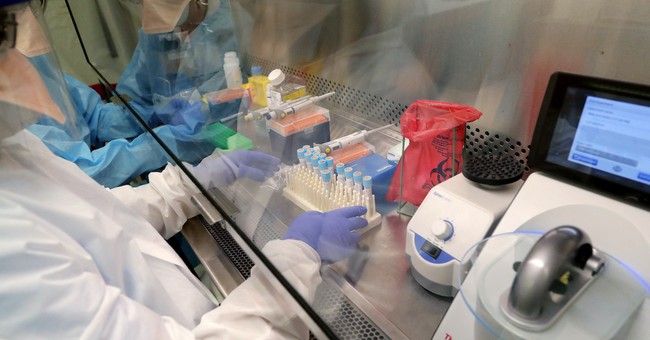
Cindy Morris, left, and Swarnamala Ratnayaka prepare RNA for testing for the new coronavirus at the molecular pathology lab at Tulane University School of Medicine in New Orleans, Thursday, April 2, 2020. The test is identical to the PCR test being used by the Centers for Disease Control to ease the testing crisis and stop the spread of COVID-19, which has hit the New Orleans area especially hard. (AP Photo/Gerald Herbert)
Here we are. Three weeks (at least, depending upon where you are) into what amounts to house arrest. Stores are told what products they can and cannot sell. A father has been handcuffed and arrested for playing with his daughter in a deserted park. People are being fined for walking on vacant beaches. Businesses have been shuttered. The economy has been thrashed. Our concept of civil liberties and the permissible use of the state’s police power may have been irrevocably moved in the direction of totalitarianism. There is literally no end in sight. So it is fair to ask how we got here.
In a word: models.
The Wuhan virus frenzy really began in earnest when a guy named Neil Ferguson published the results of a simulation he’d run on the public health impact of the virus. In it, he predicted that some 2 million Americans would die from the virus. The impact of this paper can’t be overstated. The British and Dutch governments were stampeded from pursuing what amounted to a “ride it out” strategy (which, in my view, was the only strategy even vaguely related to either science or commonsense) into throwing the emergency breaks on economic activity.
Once one model was accepted, others proliferated. Perhaps the most notable one has been that from the Institution for Health Metrics and Evaluation. This one, like the Imperial College model, has produced Doomsday results that led to panicked governors believing they had to ‘do something’ shutting down most economic activity.
These models have one unifying feature. They were all wildly and spectacularly implausible and are all being proven wildly and spectacularly wrong on a daily basis. Thomas Bossert, who was once point man for pandemics on the National Security Council, predicted a month ago that we were only 10 days away from our hospitals being overwhelmed. We presume he was relying upon data from one of these models for that bit of stupidity, but, alternatively, maybe he’s just not very bright.
So, over the next 2 weeks, we could see another 12,000-14,000 deaths for NY State alone (about half of those from NYC). I think it will be lower. I hope it will be. Even so, I don’t know how a healthcare system even the size of NY’s can cope. 🙏
— Thomas P. Bossert (@TomBossert) April 2, 2020
Now that the models are being proven to be nonsense, an industry is springing up to defend them. One of the better ones is this from The Atlantic, Don’t Believe the COVID-19 Models – That’s not what they’re for.
The most important function of epidemiological models is as a simulation, a way to see our potential futures ahead of time, and how that interacts with the choices we make today. With COVID-19 models, we have one simple, urgent goal: to ignore all the optimistic branches and that thick trunk in the middle representing the most likely outcomes. Instead, we need to focus on the branches representing the worst outcomes, and prune them with all our might. Social isolation reduces transmission, and slows the spread of the disease. In doing so, it chops off branches that represent some of the worst futures. Contact tracing catches people before they infect others, pruning more branches that represent unchecked catastrophes.
At the beginning of a pandemic, we have the disadvantage of higher uncertainty, but the advantage of being early: The costs of our actions are lower because the disease is less widespread. As we prune the tree of the terrible, unthinkable branches, we are not just choosing a path; we are shaping the underlying parameters themselves, because the parameters themselves are not fixed. If our hospitals are not overrun, we will have fewer deaths and thus a lower fatality rate. That’s why we shouldn’t get bogged down in litigating a model’s numbers. Instead we should focus on the parameters we can change, and change them.
It is a great example of kernels of truth being used to justify bullsh** projections that have devastated family finances without demonstrably proving that they saved a single life. No one has an objection to a bunch of geeks running computer simulations as an exercise in onanism. But that is not what happened here. These models were given a high profile by academicians and massive coverage by the press. They were clearly represented as predictions of what would happen. The writer just shrugs off the social and economic devastation inflicted across the globe based on decisions made upon those models with a response reminiscent of Animal House:
The other tack being taken is to say that the models are wrong because we actually did things that the models recommended and avoided a worst-case scenario. This is from the Philip Bump at the Washington Post:
A notable shift downward in projected deaths from coronavirus is already being spun as "experts were wrong!!" instead of "hey, the thing experts said would drive down deaths might be driving down deaths."https://t.co/HpUPAyc5tx pic.twitter.com/XLPD39dQfF
— Philip Bump (@pbump) April 9, 2020
The problem with this is that it is a lie. The worst-case scenarios were clearly predicated upon us doing exactly what we’ve done.
"The modelers were SO RIGHT they were actually wrong" is a hellofa take.
(Full social distancing was included in their models, Philip. These models set policy, Philip. That policy has put 15 million Americans out of work and shuttered hospitals and small businesses, Philip.) https://t.co/kk03YSBg34
— Amanda (@AmandaPresto) April 9, 2020
Time to start using more straightforward language and calling out people who don’t tell the truth, like @pbump. The original model explicitly accounted for the effect of lockdowns. It was wrong in real-time, embarrassingly so; that’s why it’s been updated. (It’s still wrong.) https://t.co/4KcjswcDWO
— Alex Berenson (@AlexBerenson) April 9, 2020
There is no defense for what has happened here. Academics, with zero responsibility or sense of decency, attempted to further their own careers by creating a public health Armageddon via highly publicized simulations. The models don’t seem to work even retrospectively, and they certainly have zero predictive value. Gutless politicians — and I hope, for our sake that they are gutless because were they stupid enough to take these simulations seriously it would call into question their ability to live outside a psychiatric facility — felt compelled to ‘do something’ based on the press howling about the results of the models. No push back against the models was even attempted…because Science.
Increasingly, our political leaders are abrogating their duty to lead to “experts” and “scientists” and the models they design. For decades, the EPA has made economic policy for the United States based on models that are probably just as reliable as the Imperial College Wuhan model. As we’re seeing, those experts and scientists have no more insight into how to solve complex problems than most anyone else. In fact, in their hubris they seem pig-ignorant of what they don’t know and are more susceptible to groupthink than any group of politicians would ever be. Because they are both unaccountable to the public and given demigod status by the media, we have become slaves to computer programs created by people with no real skin in the game. Neither Fauci nor Birx will miss a single paycheck over foisting these models on the US government.
When the dust settles here, there needs to be a formal investigation into these models and the modelers. We need to apply the lessons learned from this fiasco to the global warming cult. We need to apply it to EPA chemical safety models. We need legislation that will severely curtail the use of models in the development of public policy. And we need a few (figurative) heads on pikes to remind the experts and the scientists that they are responsible for the predictions they make.
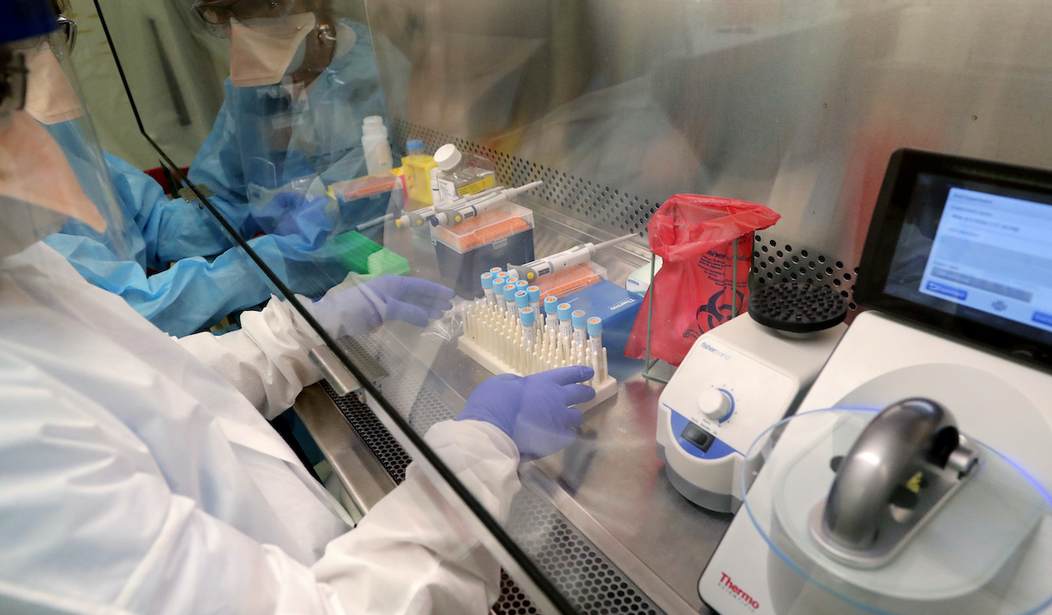




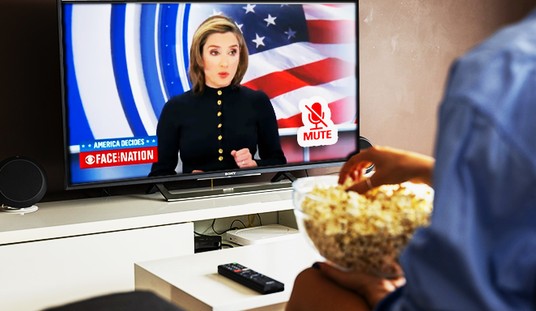



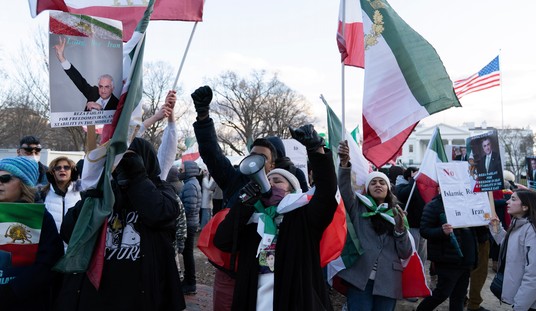


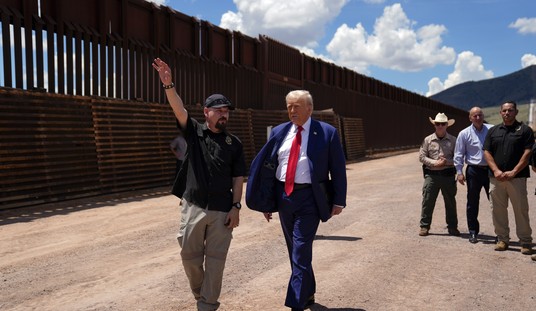
Join the conversation as a VIP Member